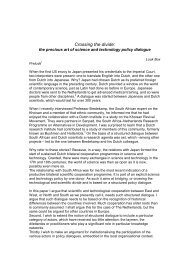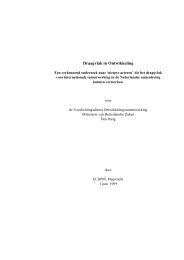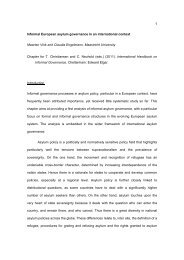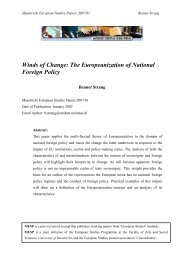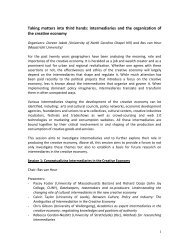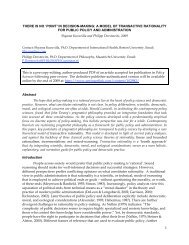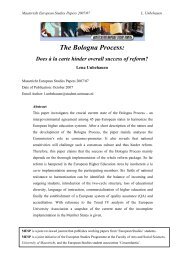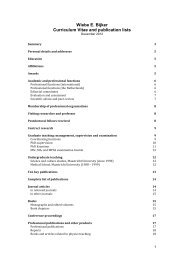the case of the synthetic dye industry, 1857–1914 - Maastricht ...
the case of the synthetic dye industry, 1857–1914 - Maastricht ...
the case of the synthetic dye industry, 1857–1914 - Maastricht ...
You also want an ePaper? Increase the reach of your titles
YUMPU automatically turns print PDFs into web optimized ePapers that Google loves.
188 J.P. Murmann and E. Homburg<br />
Fig. 3. Number <strong>of</strong> <strong>dye</strong> firms by country, <strong>1857–1914</strong><br />
to count also <strong>the</strong> number <strong>of</strong> intermediate chemical makers, which were numerous<br />
in France. Between 1862 and 1870 a constant steep decline occurred in <strong>the</strong><br />
French syn<strong>the</strong>tic <strong>dye</strong> <strong>industry</strong> from 21 to 7 firms (40 firms to 15 including intermediate<br />
makers). Between 1870 and 1914 <strong>the</strong> number <strong>of</strong> firms in <strong>the</strong> French<br />
<strong>dye</strong> <strong>industry</strong> stayed at a remarkably constant low level. 13 France is a clear example<br />
<strong>of</strong> an <strong>industry</strong> shakeout that appears to characterize many industries. The<br />
automobile <strong>industry</strong> is perhaps <strong>the</strong> most prominent <strong>case</strong> <strong>of</strong> a severe <strong>industry</strong><br />
shakeout documented in <strong>the</strong> literature (Carroll and Hannan, 1995; Klepper and<br />
Simmons, 1997). Carroll and Hannan report that between 1920 and 1930 <strong>the</strong><br />
American automobile <strong>industry</strong> and between 1924 and 1934 <strong>the</strong> German, British<br />
and French automobiles industries all experienced a severe shakeout. In <strong>the</strong> <strong>case</strong><br />
<strong>of</strong> <strong>the</strong> French <strong>dye</strong> <strong>industry</strong>, however, <strong>the</strong> shakeout came much more quickly than<br />
in <strong>the</strong> automobile <strong>industry</strong>. Carroll and Hannan (1995, p. 195) place <strong>the</strong> start<br />
<strong>of</strong> <strong>the</strong> French automobile <strong>industry</strong> in 1885, with <strong>the</strong> shakeout happening about<br />
40 years later. In <strong>the</strong> French <strong>dye</strong> <strong>industry</strong> <strong>the</strong> shakeout occurred within about<br />
a decade after <strong>the</strong> start <strong>of</strong> <strong>the</strong> syn<strong>the</strong>tic <strong>dye</strong> <strong>industry</strong> in 1858. Carroll and Hannan<br />
(2000) speculate that in high-tech industries shake-outs come more quickly.<br />
Syn<strong>the</strong>tic <strong>dye</strong>s undoubtedly were a high-tech <strong>industry</strong> in <strong>the</strong> 19 th century, partly<br />
confirming <strong>the</strong> Carroll-Hannan hypo<strong>the</strong>sis. But <strong>the</strong> fact that a clear shake-out<br />
only occurred in <strong>the</strong> French <strong>dye</strong> <strong>industry</strong> and not <strong>the</strong> o<strong>the</strong>r countries suggests<br />
13 The graph does not show a decline <strong>of</strong> <strong>the</strong> number <strong>of</strong> firms in <strong>the</strong> wake <strong>of</strong> <strong>the</strong> Franco-Prussian<br />
war. The loss <strong>of</strong> <strong>the</strong> few Alsatian firms was compensated by <strong>the</strong> formation <strong>of</strong> new French firms.




